Nitrates in Groundwater Discharges from the Azores Archipelago: Occurrence and Fluxes to Coastal Waters
Abstract
:1. Introduction
2. Hydrogeological Setting
2.1. Geology Outline
2.2. Hydrogeology Outline
3. Material and Methods
4. Results and Discussion
4.1. Data Presentation
4.2. Nitrates Occurrence and Fluxes
5. Conclusions
Supplementary Materials
Acknowledgments
Author Contributions
Conflicts of Interest
References
- Moore, W.S. Large groundwater inputs to coastal waters revealed by 226Ra enrichments. Nature 1996, 380, 612–614. [Google Scholar] [CrossRef]
- Burnett, W.C.; Bokuniewicz, H.; Huettel, M.; Moore, W.S.; Taniguchi, M. Groundwater and pore water inputs to the coastal zone. Biogeochemistry 2003, 66, 3–33. [Google Scholar] [CrossRef]
- Moore, W.S.; Sarmiento, J.L.; Key, R.M. Submarine groundwater discharge revealed by 228Ra distribution in the upper Atlantic Ocean. Nat. Geosci. 2008, 1, 309–311. [Google Scholar] [CrossRef]
- Kroeger, K.D.; Swarzenski, P.W.; Greenwood, W.J.; Reich, C. Submarine groundwater discharge to Tampa Bay: Nutrient fluxes and biogeochemistry of the coastal aquifer. Mar. Chem. 2007, 104, 85–97. [Google Scholar] [CrossRef]
- Johannes, R.E. The ecological significance of the submarine discharge of groundwater. Mar. Ecol. Prog. Ser. 1980, 3, 365–373. [Google Scholar] [CrossRef]
- Lee, Y.W.; Kim, G. Linking groundwater-borne nutrients and dinoflagellate red-tide outbreaks in the southern sea of Korea using a Ra tracer. Estuar. Coast. Shelf Sci. 2007, 71, 309–317. [Google Scholar] [CrossRef]
- Lee, Y.W.; Kim, G.; Lim, W.A.; Hwang, D.W. A relationship between submarine groundwater-borne nutrients traced by Ra isotopes and the intensity of dinoflagellate redtides occurring in the southern sea of Korea. Limnol. Oceanogr. 2010, 21, 1–10. [Google Scholar] [CrossRef]
- Garcés, E.; Basterretxea, G.; Tovar-Sánchez, A. Changes in microbial communities in response to submarine groundwater input. Mar. Ecol. Prog. Ser. 2011, 438, 47–58. [Google Scholar] [CrossRef]
- Null, K.A.; Dimova, N.T.; Knee, K.L.; Esser, B.K.; Swarzenski, P.W.; Singleton, M.J.; Stacey, M.; Paytan, A. Submarine groundwater discharge-derived nutrient loads to San Francisco Bay: Implications to future ecosystem changes. Estuar. Coast. 2012, 35, 1299–1315. [Google Scholar] [CrossRef]
- Small, C.; Nicholls, R. A global analysis of human settlement in coastal zones. J. Coast. Res. 2003, 19, 584–599. [Google Scholar]
- European Environment Agency (EEA). European Bathing Water Quality in 2015; European Environmental Report 9; EEA: Copenhagen, Denmark, 2016. [Google Scholar]
- European Environment Agency (EEA). Portuguese Bathing Water Quality in 2015; European Environmental Report, Portugal Country Report; EEA: Copenhagen, Denmark, 2016. [Google Scholar]
- Committee on Environment and Natural Resources (CENR). An Assessment of Coastal Hypoxia and Eutrophication in U.S. Waters; National Science and Technology Council Committee on Environment and Natural Resources: Washington, DC, USA, 2003. [Google Scholar]
- World Resources Institute (WRI). Eutrophication and Hypoxia in Coastal Areas: A Global Assessment of the State of Knowledge; WRI Policy Note 1; WRI: Washington, DC, USA, 2008. [Google Scholar]
- Rabalais, N.N.; Turner, R.E.; Díaz, R.J.; Justic, D. Global change and eutrophication of coastal waters. ICES J. Mar. Sci. 2009, 66, 1528–1537. [Google Scholar] [CrossRef]
- Prepas, E.E.; Charette, T. Worldwide Eutrophication of Water Bodies: Causes, Concerns, Controls. In Environmental Geochemistry, Treatise of Geochemistry; Lollar, B.S., Ed.; Elsevier: Amsterdam, The Netherlands, 2005; pp. 311–331. [Google Scholar]
- Paerl, H.W. Controlling eutrophication along the freshwater-marine continuum: Dual nutrient (N and P) reductions are essential. Estuar. Coast. 2009, 32, 593–601. [Google Scholar] [CrossRef]
- Burnett, W.C.; Wattayakorn, G.; Taniguchi, M.; Dulaiova, H.; Sojisuporn, P.; Rungsupa, S.; Ishitobi, T. Groundwater-derived nutrient inputs to the Upper Gulf of Thailand. Cont. Shelf Res. 2007, 27, 176–190. [Google Scholar] [CrossRef]
- Swarzenski, P.W.; Reich, C.; Kroeger, K.; Baskaran, M. Ra and Rn istotopes as natural tracers of submarine groundwater discharge in Tampa Bay, Florida. Mar. Chem. 2007, 104, 69–84. [Google Scholar] [CrossRef]
- Street, J.H.; Knee, K.L.; Grossman, E.E.; Paytan, A. Submarine groundwater discharge and nutrient addition to the coastal zone and coral reefs of leeward Hawaii. Mar. Chem. 2008, 109, 355–376. [Google Scholar] [CrossRef]
- Kim, G.; Kim, J.S.; Hwang, D.W. Submarine groundwater discharge from oceanic islands standing in oligotrophic oceans: Implications for global biological production and organic carbon fluxes. Limnol. Oceanogr. 2011, 56, 673–682. [Google Scholar] [CrossRef]
- Bishop, J.M.; Glenn, C.R.; Amato, D.W.; Dulai, H. Effect of land use and groundwater discharge nutrient flux. J. Hydrol. Reg. Stud. 2015, in press. [Google Scholar]
- Knee, K.L.; Crook, E.D.; Hench, J.L.; Leichter, J.J.; Paytan, A. Assessment of Submarine Groundwater Discharge (SGD) as a Source of Dissolved Radium and Nutrients to Moorea (French Polynesia) Coastal Waters. Estuar. Coast. 2016, 39, 1651–1668. [Google Scholar] [CrossRef]
- Prouty, N.G.; Swarzenski, P.W.; Fackrell, J.K.; Johannesson, K.; Palmore, C.D. Groundwater-derived nutrient and trace element transport to a nearshore Kona coral ecosystems: Experimental mixing model results. J. Hydrol. Reg. Stud. 2016, in press. [Google Scholar] [CrossRef]
- Hwang, D.; Kim, G.; Lee, Y.; Yang, H. Estimating submarine inputs of groundwater and nutrients to a coastal bay using radium isotopes. Mar. Chem. 2005, 96, 61–71. [Google Scholar] [CrossRef]
- Knee, K.L.; Layton, B.A.; Street, J.H.; Boehm, A.B.; Paytan, A. Sources of nutrients and fecal indicator bacteria to nearshore waters on the North Shore of Kaua’i (Hawai’i, USA). Estuar. Coast. 2008, 31, 607–622. [Google Scholar] [CrossRef]
- Slomp, C.P.; Van Cappellen, P. Nutrient inputs to the coastal ocean through submarine groundwater discharge: Controls and potential impact. J. Hydrol. 2004, 295, 64–86. [Google Scholar] [CrossRef]
- Breier, J.A.; Nidzieko, N.; Monismith, S.; Moore, W.; Paytan, A. Tidally regulated chemical fluxes across the sediment-water interface in Elkhorn Slough, California: Evidence from a coupled geochemical and hydrodynamic approach. Limnol. Oceanogr. 2009, 54, 1964–1980. [Google Scholar] [CrossRef]
- Null, K.A.; Corbett, D.R.; DeMaster, D.J.; Burkholder, J.M.; Thomas, C.J.; Reed, R.E. Porewater advection of ammonium into the Neuse River Estuary, North Carolina, USA. Estuar. Coast. Shelf Sci. 2011, 95, 314–325. [Google Scholar] [CrossRef]
- Velthof, G.; Oudendag, D.; Witzke, H.; Asman, W.; Klimont, Z.; Oenema, O. Integrated assessment of Nitrogen Losses from Agriculture in EU-27 using MITERRA-EUROPE. J. Environ. Qual. 2009, 38, 402–417. [Google Scholar] [CrossRef] [PubMed]
- Stamatis, G.; Parpodis, K.; Filintas, A.; Zagana, E. Groundwater quality, nitrate pollution and irrigation environmental management in the Neogene sediments of an agricultural region in central Thessaly (Greece). Environ. Earth. Sci. 2001, 64, 1081–1105. [Google Scholar] [CrossRef]
- Menció, A.; Boy, M.; Mas-Pla, J. Analysis of vulnerability factors that control nitrate occurrence in natural springs (Osona Region, NE Spain). Sci. Total Environ. 2011, 409, 3049–3058. [Google Scholar] [CrossRef] [PubMed]
- Jayasingha, P.; Pitawala, A.; Dharmagunawardhane, H. Vulnerability of Coastal Aquifers Due to Nutrient Pollution from Agriculture: Kalpitiya, Sri Lanka. Water Air Soil Pollut. 2011, 219, 563–577. [Google Scholar] [CrossRef]
- Heaton, T.; Stuart, M.; Sapiano, M.; Sultana, M. An isotope study of the sources of nitrate in Malta’s groundwater. J. Hydrol. 2012, 414–415, 244–254. [Google Scholar] [CrossRef]
- Olson, B.; Bennett, R.; McKenzie, R.; Ormann, T.; Atkins, R. Nitrate leaching in two irrigated soils with different rates of cattle manure. J. Environ. Qual. 2009, 38, 2218–2228. [Google Scholar] [CrossRef] [PubMed]
- Infascelli, R.; Pelorosso, R.; Boccia, L. Spatial assessment of animal manure spreading and groundwater nitrate pollution. Geospatial Health 2009, 4, 27–38. [Google Scholar] [CrossRef] [PubMed]
- Direção Regional do Ordenamento do Território e dos Recursos Hídricos (DROTRH). Carta de Ocupação do Solo da Região Autónoma dos Açores; DROTRH: Ponta Delgada, Portugal, 2007. (In Portuguese) [Google Scholar]
- Santos, M.C.; Pacheco, D.; Santana, A.F.; Muelle, H. Cyanobacteria blooms in Sete Cidades lake (São Miguel Island–Azores). Algol. Stud. 2005, 117, 393–406. [Google Scholar] [CrossRef]
- Ribeiro, D.C.; Martins, G.; Nogueira, R.; Cruz, J.V.; Brito, A.G. Phosphorus fractionation in volcanic lake sediments (Azores–Portugal). Chemosphere 2008, 70, 1256–1263. [Google Scholar] [CrossRef] [PubMed] [Green Version]
- Martins, G.; Ribeiro, D.; Pacheco, D.; Cruz, J.V.; Cunha, R.; Gonçalves, V.; Nogueira, R.; Brito, A.G. Prospective scenarios for water quality and ecological status in Lake Sete Cidades (Portugal): The integration of mathematical modelling in decision processes. Appl. Geochem. 2008, 23, 2171–2181. [Google Scholar] [CrossRef] [Green Version]
- Cruz, J.V.; Pacheco, D.; Cymbron, R.; Mendes, S. Monitoring of the groundwater chemical status in the Azores archipelago (Portugal) in the context of the EU Water Framework Directive. Environ. Earth Sci. 2009, 61, 173–186. [Google Scholar] [CrossRef]
- Cruz, J.V.; Pacheco, D.; Coutinho, R.; Cymbron, R.; Mendes, S.; Antunes, P.; Fontiela, J.; Freire, P. Chemical monitoring of river water bodies in an EU outermost region: Examples from the Azores archipelago (Portugal). J. Environ. Monit. 2010, 12, 2216–2225. [Google Scholar] [CrossRef] [PubMed]
- Cruz, J.V.; Silva, M.O.; Dias, M.I.; Prudêncio, M.I. Groundwater composition and pollution due to agricultural practices at Sete Cidades volcano (Azores, Portugal). Appl. Geochem. 2013, 29, 162–173. [Google Scholar] [CrossRef]
- Cruz, J.V.; Fontiela, J.; Prada, S.; Andrade, C. The chemical status of groundwater and pollution risk in the Azores archipelago (Portugal). Environ. Earth Sci. 2015, 73, 2763–2777. [Google Scholar] [CrossRef]
- Administração Hidrográfica dos Açores-Direção Regional do Ambiente (AHA-DRA). Plano de Gestão da Região Hidrográfica dos Açores—RH9; Versão para Consulta Pública; Secretaria Regional do Ambiente e do Mar: Ponta Delgada, Portugal, 2015. (In Portuguese)
- Pacheco, J.M.; Ferreira, T.; Queiroz, G.; Wallenstein, N.; Coutinho, R.; Cruz, J.V.; Pimentel, A.; Silva, R.; Gaspar, J.L.; Goulart, C. Notas sobre a geologia do arquipélago dos Açores. In Geologia de Portugal; Dias, R., Araújo, A., Terrinha, P., Kullberg, J.C., Eds.; Escolar Editora: Lisboa, Portugal, 2013; pp. 595–690. (In Portuguese) [Google Scholar]
- Gaspar, J.L.; Queiroz, G.; Ferreira, T.; Medeiros, A.R.; Goulart, C.; Medeiros, J. Earthquakes and Volcanic Eruptions in the Azores Region: Geodynamic Implications from Major Historical Events and Instrumental Seismicity. In Volcanic Geology of São Miguel Island (Azores Archipelago), Geological Society Memoirs 44; Gaspar, J.L., Guest, J.E., Duncan, A.M., Barriga, F.J.A.S., Chester, D.K., Eds.; Geological Society of London: London, UK, 2015; pp. 33–49. (In Portuguese) [Google Scholar]
- Gaspar, J.L.; Queiroz, G.; Pacheco, J.M.; Ferreira, T.; Wallenstein, N.; Almeida, M.H.; Coutinho, R. Basaltic lava balloons produced during the 1998–2001 Serreta submarine ridge eruption (Azores). In Explosive Subaqueous Volcanism, Geophysical Monograph 140; White, J.D.L., Smellie, J.L., Clague, D.A., Eds.; American Geophysical Union: Washington, DC, USA, 2003; pp. 205–212. [Google Scholar]
- Abdel-Monen, A.; Fernandez, L.; Boone, G. K/Ar ages from the eastern Azores group (Santa Maria, São Miguel and the Formigas Islands). Lithos 1975, 4, 247–254. [Google Scholar] [CrossRef]
- Cruz, J.V. Groundwater and volcanoes: Examples from the Azores archipelago. Environ. Geol. 2003, 44, 343–355. [Google Scholar] [CrossRef]
- Cruz, J.V. Ensaio Sobre a Água Subterrânea nos Açores. História, Ocorrência e Qualidade; Secretaria Regional do Ambiente: Ponta Delgada, Portugal, 2004. (In Portuguese)
- Direção Regional do Ordenamento do Território e dos Recursos Hídricos—Instituto da Água (DROTRH/INAG). Plano Regional da Água. Relatório Técnico; DROTRH-INAG: Ponta Delgada, Portugal, 2001. (In Portuguese) [Google Scholar]
- Yamamoto, S. Volcano Body Springs in Japan; Kokon-Shoin: Tokyo, Japan, 1995. [Google Scholar]
- Cabral, L.; Andrade, C.; Coutinho, R.; Cruz, J.V. Groundwater composition in perched-waer bodies in the north flank of Fogo volcano (São Miguel, Azores): Main causes and comparison with river water chemistry. Environ. Earth Sci. 2015, 73, 2779–2792. [Google Scholar] [CrossRef]
- Cruz, J.V.; Amaral, C. Major Ion chemistry of groundwaters from perched-water bodies at Azores (Portugal) volcanic archipelago. Appl. Geochem. 2004, 19, 445–459. [Google Scholar] [CrossRef]
- Freire, P.; Andrade, C.; Coutinho, R.; Cruz, J.V. Spring geochemistry in an active volcanic environment (São Miguel, Azores): Source and fluxes of inorganic solutes. Sci. Total Environ. 2014, 466–467, 475–489. [Google Scholar] [CrossRef] [PubMed]
- Vystavna, Y.; Huneau, F.; Schäfer, J.; Motelica-Heino, M.; Blanc, G.; Larrose, A.; Vergeles, Y.; Diadin, D.; Le Coustumer, P. Distribution of trace elements in waters and sediments of the Seversky Donets transboundary watershed (Kharkiv region, Eastern Ukraine. Appl. Geochem. 2012, 27, 2077–2087. [Google Scholar] [CrossRef] [Green Version]
- Yakovlev, V.; Vystavna, Y.; Diadin, D.; Vergeles, Y. Nitrates in springs and rivers of East Ukraine: Distribution, contamination and fluxes. Appl. Geochem. 2013, 53, 71–78. [Google Scholar] [CrossRef]
- Cruz, J.V.; Andrade, C. Natural background groundwater composition in the Azores archipelago (Portugal): A hydrogeochemical study and threshold value determination. Sci. Total Environ. 2015, 520, 127–135. [Google Scholar] [CrossRef] [PubMed]
- Rad, S.D.; Allègre, C.J.; Louvat, P. Hidden erosion on volcanic islands. Earth Planet. Sci. Lett. 2007, 262, 109–124. [Google Scholar] [CrossRef]
- Freire, P.; Andrade, C.; Coutinho, R.; Cruz, J.V. Fluvial geochemistry in São Miguel Island (Azores, Portugal): Source and fluxes of inorganic solutes in an active volcanic environment. Sci. Total Environ. 2013, 454–455, 154–169. [Google Scholar] [CrossRef] [PubMed]
- Beck, A.J.; Tsukamoto, Y.; Tovar-Sanchez, A.; Huerta-Diaz, M.; Bokuniewicz, H.J.; Sañudo-Wilhelmy, S.A. Importance of geochemical transformations in determining submarine groundwater discharge-derived trace metal and nutrient fluxes. Appl. Geochem. 2007, 22, 477–490. [Google Scholar] [CrossRef]
- Cruz, J.V.; Coutinho, R.; Pacheco, D.; Cymbron, R.; Antunes, P.; Freire, P.; Mendes, S. Groundwater salinization in the Azores archipelago (Portugal). Environ. Earth Sci. 2011, 62, 1273–1285. [Google Scholar] [CrossRef]
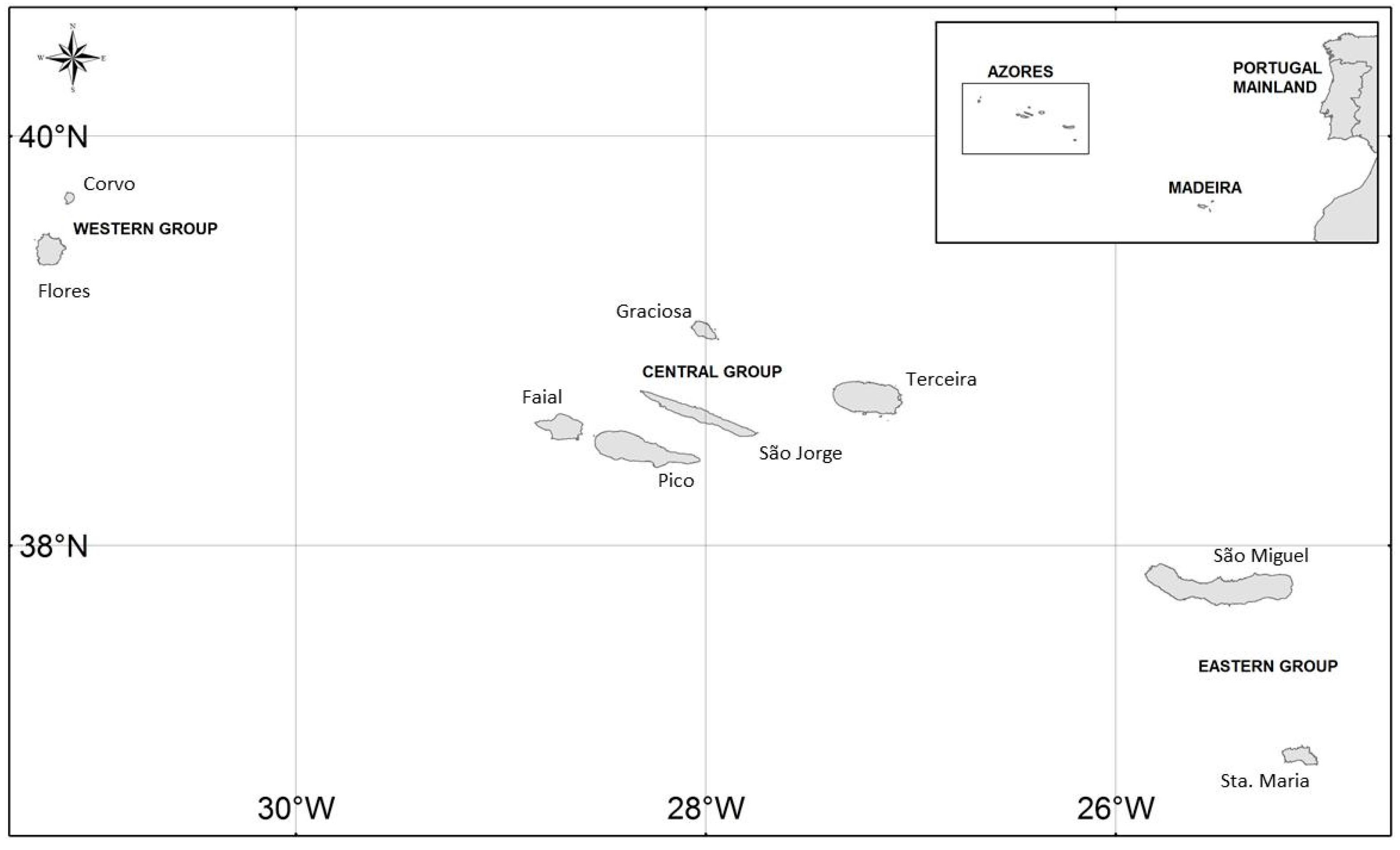
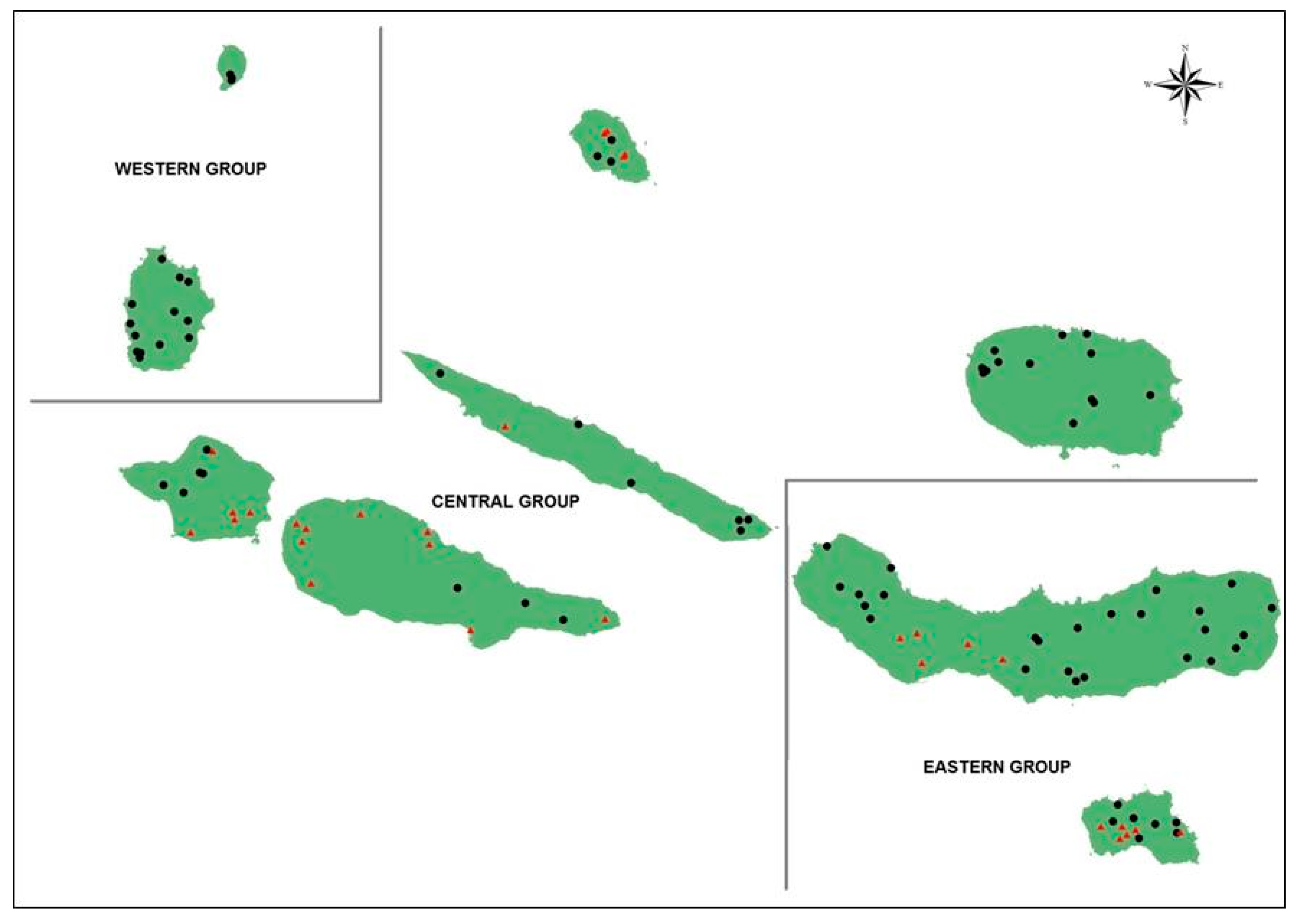

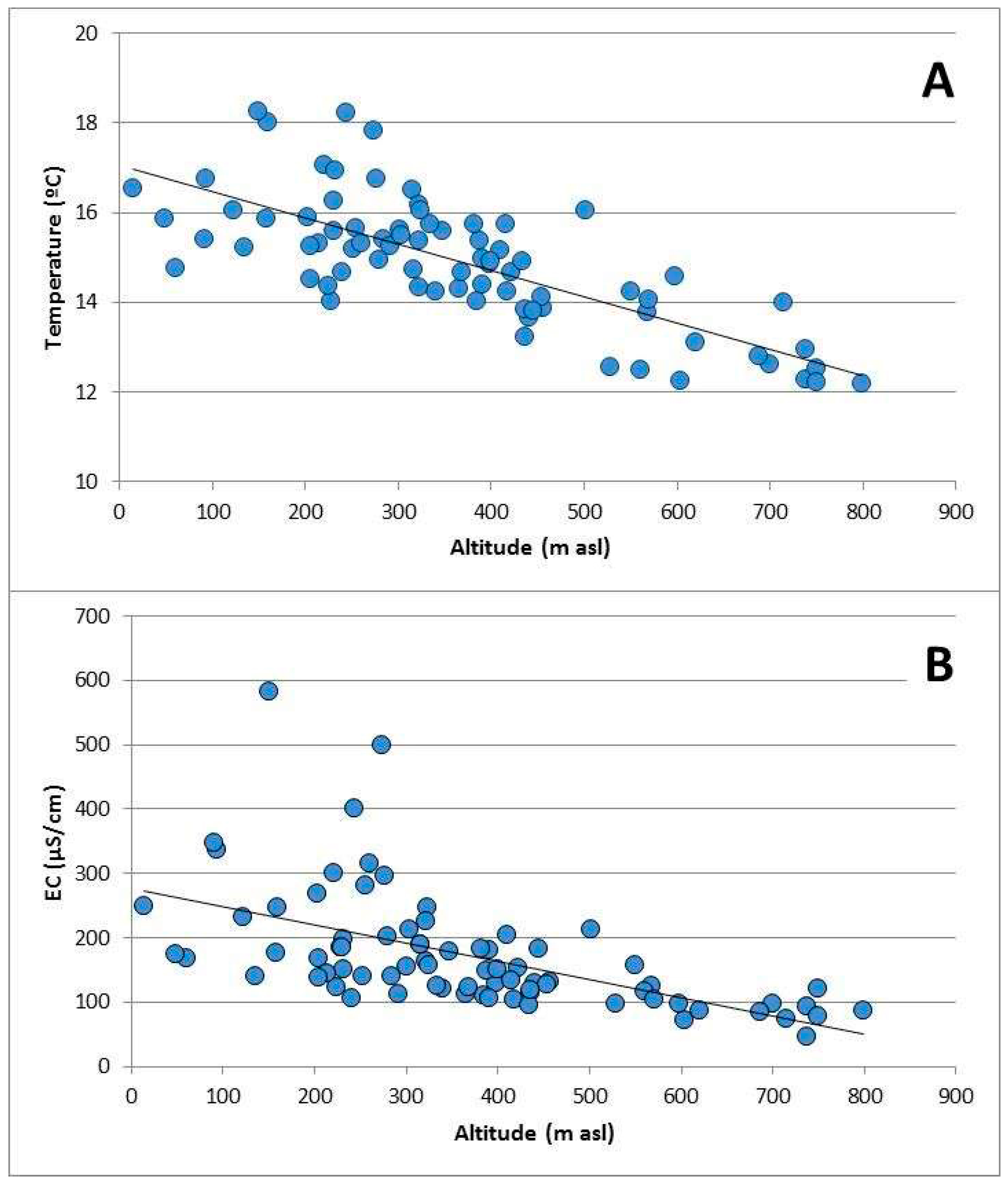

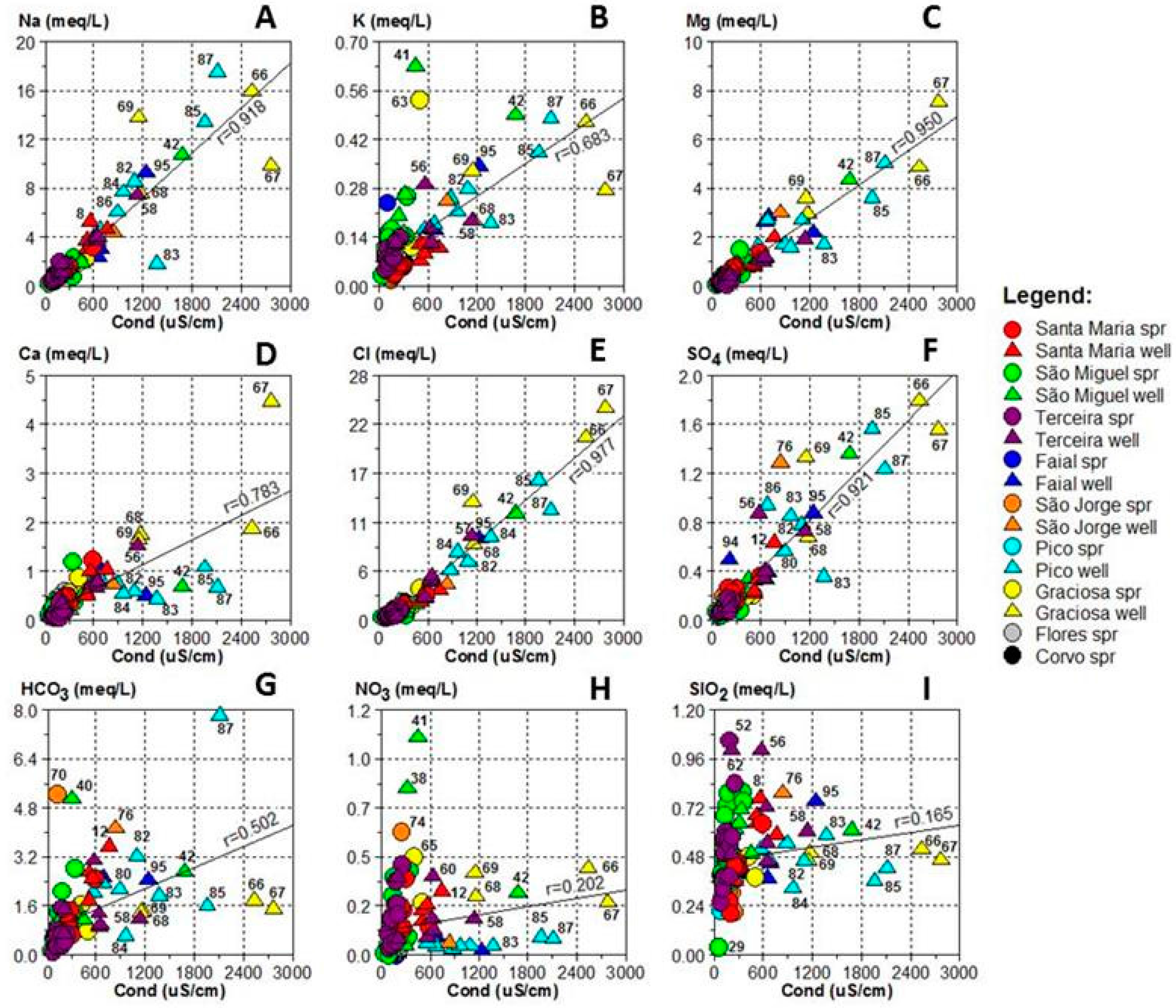
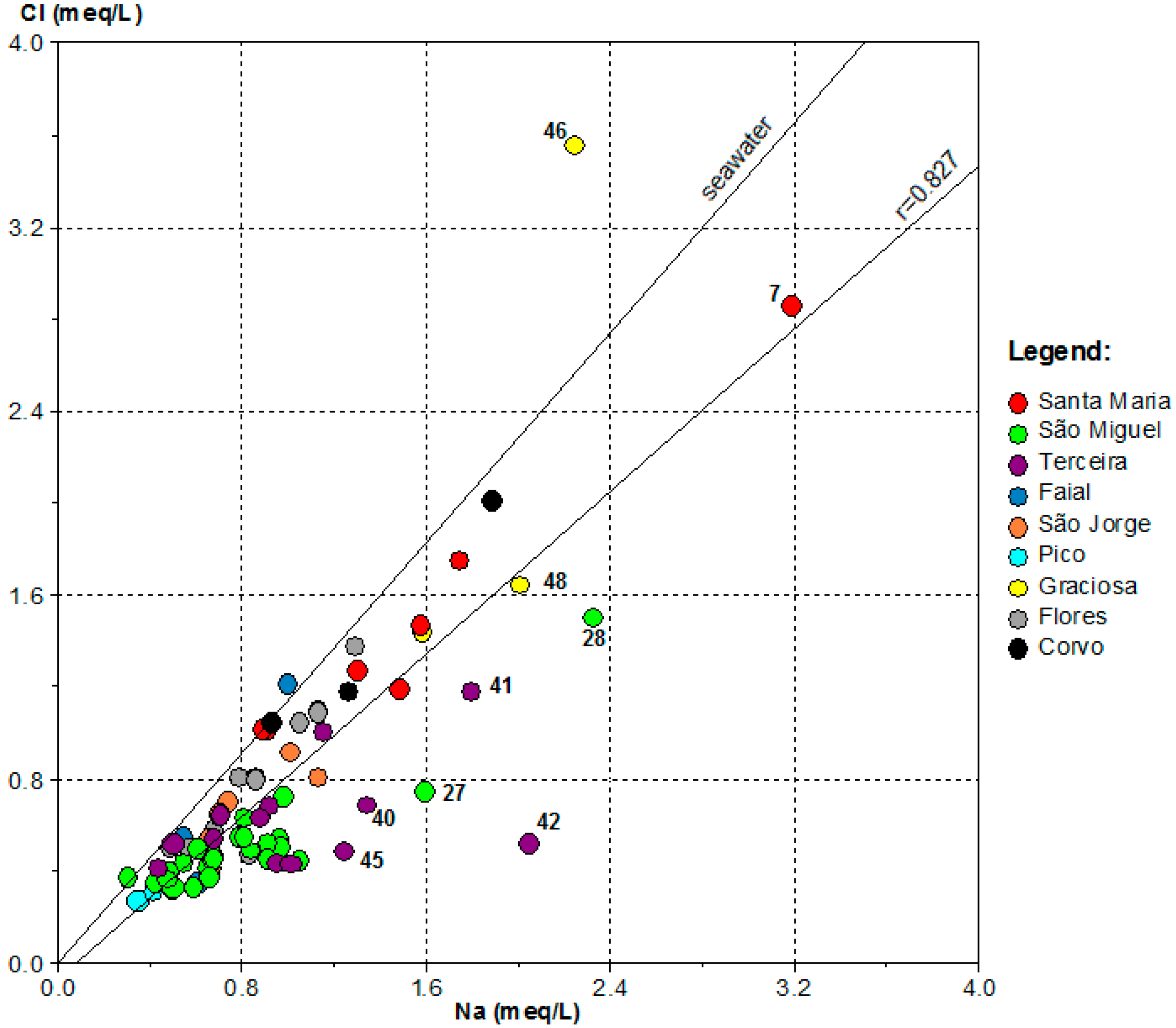
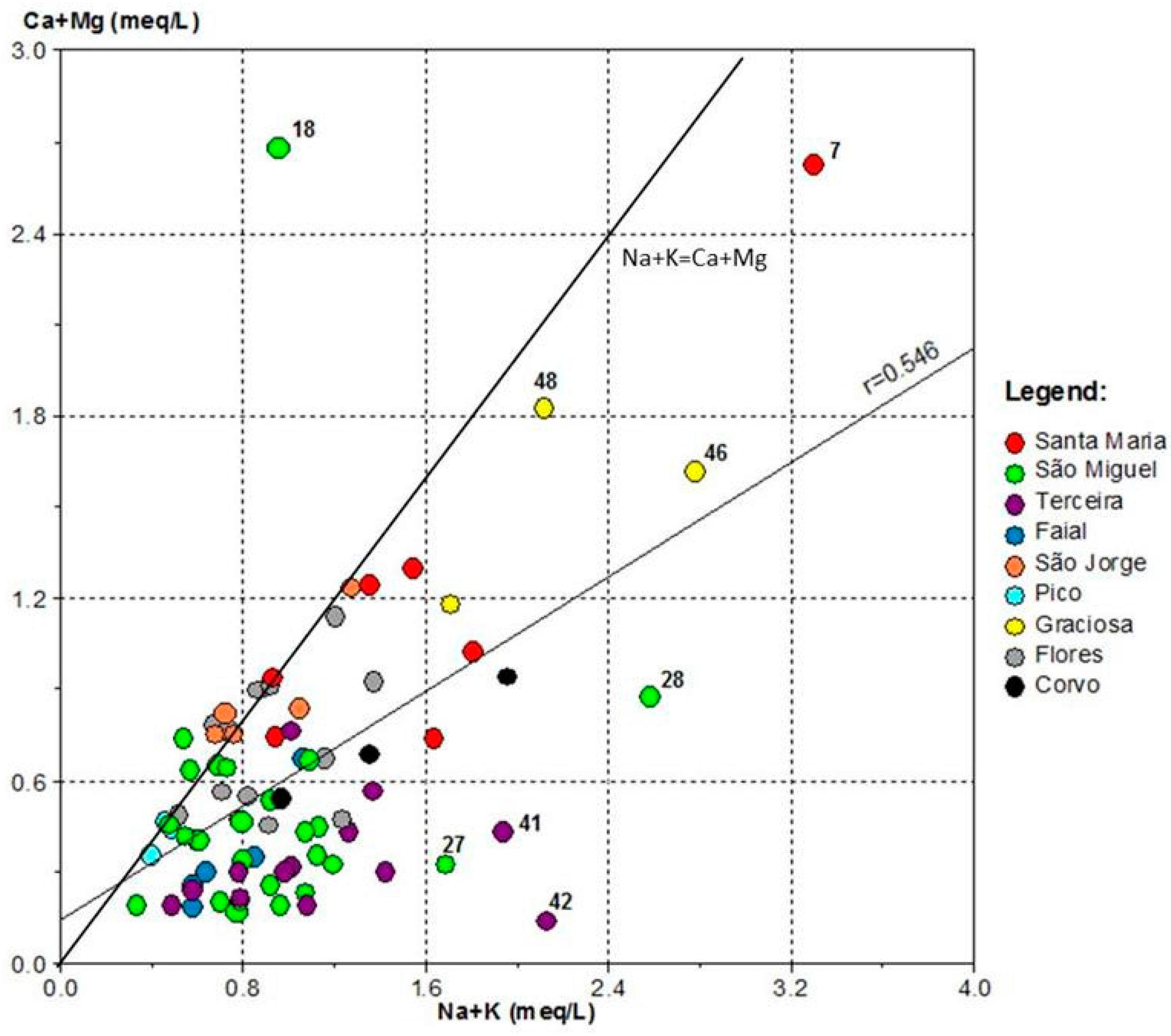
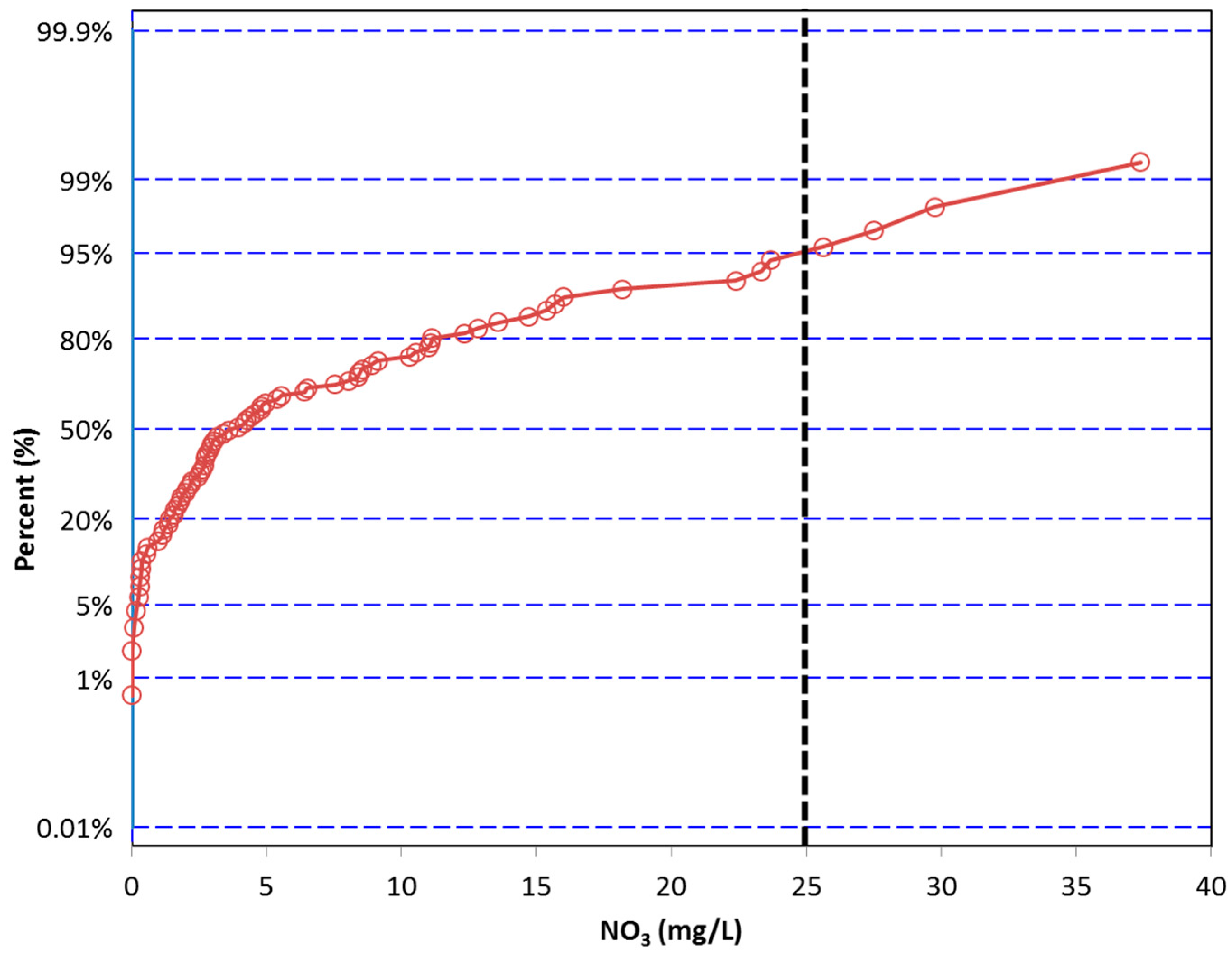
| Island | Area (km2) | P (mm) | R (%) | Rt (m3/a) | Mean NO3 (mol/m3) | NO3 Flux (103 mol/km2/a) | N-NO3 Flux (103 mol/km2/a) |
|---|---|---|---|---|---|---|---|
| Santa Maria | 96.9 | 1200 | 21.6 | 2.5 × 107 | 1.9 × 10−1 ± 8.9 × 10−2 | 49.5 ± 22.9 | 11.2 ± 5.2 |
| São Miguel | 744.5 | 1722 | 29.7 | 3.8 × 108 | 9.9 × 10−2 ± 1.1 × 10−1 | 50.8 ± 56.7 | 11.5 ± 12.8 |
| Terceira | 400.3 | 1585 | 30.7 | 1.9 × 108 | 1.7 × 10−1 ± 1.2 × 10−1 | 84.1 ± 59.6 | 19.0 ± 13.5 |
| Graciosa | 60.7 | 966 | 25.3 | 1.5 × 107 | 2.7 × 10−1 ± 1.7 × 10−1 | 66.1 ± 40.6 | 14.9 ± 9.2 |
| São Jorge | 243.3 | 2416 | 37.2 | 2.2 × 108 | 2.1 × 10−1 ± 1.8 × 10−1 | 190.6 ± 162.9 | 43.1 ± 36.8 |
| Pico | 444.8 | 2517 | 51.7 | 5.8 × 108 | 2.1 × 10−2 ± 1.6 × 10−2 | 27.3 ± 20.3 | 6.2 ± 4.6 |
| Faial | 173.1 | 1633 | 27.8 | 7.9 × 107 | 1.1 × 10−2 ± 1.3 × 10−2 | 5.2 ± 5.7 | 1.2 ± 1.3 |
| Flores | 141.0 | 2647 | 26.1 | 9.7 × 107 | 3.0 × 10−2 ± 1.4 × 10−2 | 21.0 ± 9.8 | 4.8 ± 2.2 |
| Corvo | 17.1 | 1901 | 25.5 | 8.3 × 106 | 5,8 × 10−2 ± 2.0 × 10−2 | 28.3 ± 9.8 | 6.4 ± 2.2 |
| Total | 2321.7 | - | - | - | - | 522.9 | 118.3 |
| Island | River | Discharge (106 m3/a) | NO3 (mg/L) | NO2 (µg/L) | NH4 (µg/L) | Total NO3 Flux (103 mol/km2/a) | Total N Flux (103 mol/km2/a) |
|---|---|---|---|---|---|---|---|
| Santa Maria | São Francisco | 2.34 | 7.7 | 196.7 | 140.7 | 27.2 | 7.7 |
| Island | 31.6 | 7.7 | 196.7 | 140.7 | 40.5 | 11.6 | |
| São Miguel | Grande | 10.66 | 2.6 | 13.0 | 102.5 | 24.1 | 8.1 |
| Caldeirões | 6.07 | 8.5 | 15.7 | 20.0 | 70.5 | 16.4 | |
| Quente | 4.65 | 3.3 | 31.9 | 99.1 | 9.5 | 2.9 | |
| Faial Terra | 5.45 | 5.4 | 7.5 | 22.0 | 30.7 | 7.3 | |
| Guilherme | 8.48 | 0.6 | 2.5 | 20.0 | 6.0 | 1.9 | |
| Povoação | 5.04 | 5.8 | 11.5 | 21.3 | 16.2 | 3.8 | |
| Pelâmes | 0.65 | 8.1 | 22.3 | 20.0 | 23.7 | 5.5 | |
| Praia | 3.13 | 2.2 | 3.3 | 15.0 | 19.5 | 4.8 | |
| Salga | 5.03 | 6.3 | 7.8 | 7.8 | 57.0 | 13.1 | |
| Seca | 5.71 | 2.4 | 87.0 | 111.8 | 14.3 | 5.2 | |
| Island | 245.94 | 4.5 | 20.2 | 43.9 | 24.0 | 6.1 | |
| Faial | Flamengos | 5.85 | 13.1 | 94.7 | 34.0 | 78.0 | 18.4 |
| Island | 55.13 | 13.1 | 94.7 | 34.0 | 67.5 | 15.9 | |
| Flores | Badanela | 10.34 | 3.7 | 7.8 | 25.0 | 46.1 | 11.3 |
| Grande | 11.65 | 0.8 | 3.6 | 20.0 | 9.6 | 2,8 | |
| Fazenda | 2.93 | 3.2 | 42.0 | 25.0 | 12.6 | 3.2 | |
| Seca | 12.0 | 1.3 | 2.6 | 20.0 | 25.3 | 6.8 | |
| Island | 71.5 | 2.3 | 14.0 | 22.5 | 18.5 | 4.7 | |
| Terceira | Island | 142.94 | 4.7 | 28.9 | 44.0 | 27.0 | 6.8 |
| São Jorge | Island | 103.41 | 4.7 | 28.9 | 44.0 | 32.1 | 8.1 |
| Graciosa | Island | 6.13 | 4.7 | 28.9 | 44.0 | 7.6 | 1.9 |
| Pico | Island | 180.08 | 4.7 | 28.9 | 44.0 | 30.6 | 7.7 |
| Corvo | Island | 7.51 | 4.7 | 28.9 | 44.0 | 33.2 | 8.4 |
| Total | - | - | - | - | - | 281.0 | 71.2 |
© 2017 by the authors. Licensee MDPI, Basel, Switzerland. This article is an open access article distributed under the terms and conditions of the Creative Commons Attribution (CC BY) license ( http://creativecommons.org/licenses/by/4.0/).
Share and Cite
Cruz, J.V.; Andrade, C.; Pacheco, D.; Mendes, S.; Cymbron, R. Nitrates in Groundwater Discharges from the Azores Archipelago: Occurrence and Fluxes to Coastal Waters. Water 2017, 9, 125. https://doi.org/10.3390/w9020125
Cruz JV, Andrade C, Pacheco D, Mendes S, Cymbron R. Nitrates in Groundwater Discharges from the Azores Archipelago: Occurrence and Fluxes to Coastal Waters. Water. 2017; 9(2):125. https://doi.org/10.3390/w9020125
Chicago/Turabian StyleCruz, J. Virgílio, César Andrade, Dina Pacheco, Sandra Mendes, and Raquel Cymbron. 2017. "Nitrates in Groundwater Discharges from the Azores Archipelago: Occurrence and Fluxes to Coastal Waters" Water 9, no. 2: 125. https://doi.org/10.3390/w9020125
APA StyleCruz, J. V., Andrade, C., Pacheco, D., Mendes, S., & Cymbron, R. (2017). Nitrates in Groundwater Discharges from the Azores Archipelago: Occurrence and Fluxes to Coastal Waters. Water, 9(2), 125. https://doi.org/10.3390/w9020125








